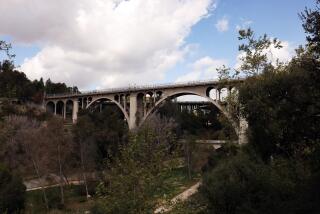A Story of Marginalized Colonists Not in History Books
- Share via
THE WISHED FOR COUNTRY
By Wayne Carlin
Curbstone Press
342 pages, $16.95 (paper)
Children in Maryland public schools half a century ago learned about the arrival of the Catholic colonists on the Ark and the Dove in 1634 and the famous Act of Toleration of 1649, granting the freedom of the colony to both Catholics and Protestants.
They did not learn about the miseries that greeted the new colonists, nor about the dire conditions of the indentured servants who made up the majority of the colonists, nor the ubiquitous presence of black slaves, nor the bloody battles with the Indians. In particular, they were not made aware that around St. Mary’s City in southernmost Maryland there exists to this day a community of people descended from the couplings in the colony’s earliest days of whites, blacks and Native Americans.
They were, and are, called Wesorts, presumably from “we sort of people.” They spoke a special kind of pidgin English, traces of which survive.
“The Wished For Country” is Wayne Karlin’s attempt in novel form to bring to life the original Wesorts and their turbulent world. It is of a piece with the movement among many modern historians to go beyond and below the traditional view of history as the sum of its major figures to limn the lives and actions of the common people. His nonprofit publisher, Curbstone Press, specializes in that kind of history.
Karlin is a professor in southern Maryland who has published three previous books and a memoir, “Rumors and Stones,” about searching in Poland for family members who disappeared in the Holocaust. He lives among descendants of his characters in “The Wished For Country.”
As an attempt at re-creating history, the novel is commendable. He mixes people remembered by history with characters he has invented. His description of the territory--steamy hot and mosquito-ridden in summer, damp and dismally cold in winter--is vivid. The woods and waters of southern Maryland and its neighborhood, stretching from the Great Falls of the Potomac to the gigantic cypresses of the Great Dismal Swamp in Virginia, are presented as they must have been in those days.
“The Wished For Country,” a phrase from the journal of the historical Jesuit father Andrew White, is ironic. For the country that all of them--Catholic gentlemen, Protestant indentured servants, Indians and black slaves--eventually got was something none of them could have wanted.
The book does a good job of describing how it all might have come about: The rivalry of Catholic and Protestant settlers; their alliances with Indian tribes fighting one another; the Jesuits’ attempts to convert the Indians; the slaves’ terrible life at the bottom of the heap and the endless torture and killing. Life was nasty, and it was brutal and it was short.
As a novel, the book is less successful. Most of the principal characters are stylized rather than fully realized. Their language is too often grandiose without the ring of authenticity. Their musings about God and Christ sound excessively academic. Karlin’s attempt to convey the thoughts of a panther is especially unpersuasive.
One character, the leading one, does appear in full face and body. That he does is remarkable, for he is the one you might think least accessible to a 21st century writer trying to imagine life in a 17th century backwater. He is Ezekiel, a slave from Dahomey by way of Barbados. Of Ezekiel, Karlin writes with passion and empathy.
Among those Karlin generously credits for help in writing his book is Lucille Clifton, “who,” he says, “lent me some of the story of her Dahomey ancestors, and their gifted fingers [in carving wood] and the gifts they have given her of seeing the true patterns under the illusions and mists of this world, and for bringing that vision to words.” Karlin’s dexterous translation of that vision is one of this book’s special pleasures.
More to Read
Sign up for our Book Club newsletter
Get the latest news, events and more from the Los Angeles Times Book Club, and help us get L.A. reading and talking.
You may occasionally receive promotional content from the Los Angeles Times.










